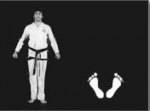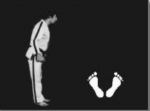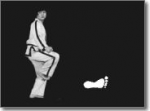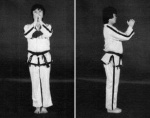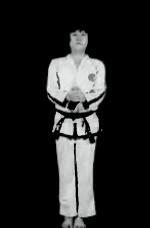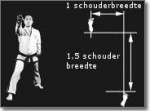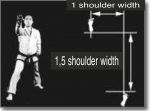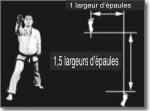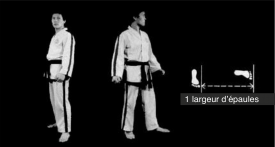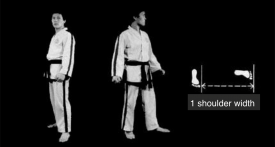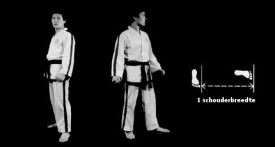Stances
>>There are all stances you learn in taekwondo, in the order of your level.
CHARYOT SOGI - Aandacht stand
Dit is de stand die wordt gebruikt voor aandacht, voor en na het sporten.
1. Voeten vormen een hoek van 45 graden.
2. Laat de vuisten op natuurlijke wijze vallen. De ellebogen zijn licht gebogen.
3. De vuisten zijn licht gebalanceerd.
4. De ogen kijken vooruit, net boven de horizontale lijn.
Terug naar top van deze pagina - Terug naar de welkom pagina
CHARYOT SOGI - Attention stance
This is the position used for attention, before and after exercise.
1. Feet form an angle of 45 degrees.
2. Drop fists down naturally. The elbows are slightly curved/bended.
3. The fists are clenched slightly.
4. The eyes look forward, just above the horizontal line.
Back to top of page - Back to Welcome Page
CHARYOT SOGI - Position d'attention
Ceci est la position utilisée pour l'attention, avant et après l'exercice.
1. Les pieds forment un angle de 45 degrés.
2. Laissez tomber les poings naturellement. Les coudes sont légèrement incurvés / pliés.
3. Les poings sont légèrement serrés.
4. Les yeux regardent vers l'avant, juste au-dessus de la ligne d'horizon.
Retour en haut de la page - Menu principal
GUNNUN SOGI - Loop stand
Dit is een sterke stand, zowel voor als achter, zowel aanvallend als verdedigend.
Verplaats een van beide voeten naar voren of naar achteren.
De lengte tussen beide voeten dient anderhalf schouderbreedte te zijn, terwijl de breedte tussen beide voeten één schouder breedte is.
Een stand met een lengte langer dan anderhalf schouderbreedte maakt de beweging traag en is men kwetsbaar voor een aanval van de zijkant, voorkant of achterkant.
Buig het voorste been, zodat de hiel in een rechte lijn zit met de knie. Het achterste been dient geheel gestrekt te zijn. >
Verdeel het lichaamsgewicht gelijk over beide voeten. Zorg ervoor dat de tenen van het voorste been naar voren wijzen.
De tenen van de voet van het achterste been behoren maximaal 25 graden naar buiten te wijzen.
Wanneer dit groter is dan 25 graden dan wordt het achterste been kwetsbaarder voor een aanval van achteren.
Span de spieren van beide voeten met het gevoel om ze naar elkaar te brengen.
Terug naar top van deze pagina - Terug naar de welkom pagina
GUNNUN SOGI - Position de marche
C’est une position de force tant à l’avant qu’à l’arrière, autant pour attaquer que pour défendre.
Déplacez un des deux pieds vers l’avant ou vers l’arrière. La longueur entre les deux pieds est une fois et demi la largeur des épaules tandis que la largeur est égale à la largeur des épaules.
Une position plus longue rend le déplacement lent et rend vulnérable à une attaque de côté, tant à l’avant qu’à l’arrière. Pliez la jambe avant de manière à ce que le talon soit en ligne avec le genou. La jambe arrière reste tendue. Le poids est réparti de manière égale sur les deux pieds. Les orteils du pieds avant sont dirigés vers l’avant, ceux de la jambe arrière seront dirigés à maximum 25° vers l’extérieur.
Quand on dépasse ces 25°, cela rend la jambe arrière vulnérable à une attaque par l’arrière. Tendez les muscles des deux pieds comme pour les ramener l’un vers l’autre.
Retour en haut de la page - Menu principal
GUNNUN SOGI - Walking stance
This is a strong position, both front and rear feet are offensive and defensive.
Move one of feet forwards or backwards. The length between both feet should be the length of the shoulders.
A stand with a length longer than a one and a half shoulder width makes the movement slow and one is vulnerable to attack from the side, front or back.
Bend the front leg so that the heel in a straight aligns with the knee. The rear leg has to be completely stretched.
Distribute your body weight equally on both feet. Make sure the toes of the front foot pointing forward.
The toes of the back-foot must be pointed 25 degrees outwards When this is more than 25 degrees, the rear leg is more vulnerable to an attack from behind.
Tighten the muscles of both feet with the sense to bring them together.
Tighten the muscles of both feet with the sense to bring them together.
Back to top of page - Back to Welcome Page
JUNBI SOGI - Klaar stand
Tae-kwon-do heeft veel modi, die naar voren komen in de patronen. Deze stand is geen onderdeel van een actie, maar is een stand van waaruit de studentenbeweging begint. Het is ideaal om de concentratie te verhogen.
BTerug naar top van deze pagina - Terug naar de welkom pagina
JUNBI SOGI - Position prêt
Le Taekwondo a beaucoup de positions que l’on retrouve dans les tuls.
La position Prêt ne fait pas partie des mouvements, mais elle est la position à partir de laquelle l’élève commence. Cette position est idéale pour augmenter la concentration.
Retour en haut de la page - Menu principal
JUNBI SOGI - Ready stance
Tae-kwon-do has many modes, which emerge in the patterns. The ready stance is not part of an action, but it is a position from which the student starts his pattern. This position is ideal for increasing the concentration.
Back to top of page - Back to Welcome Page
KYONG YE JASE - Greeting stance
This is the attitude and the movement that one must make when greeting the teacher, a fellow student, the jury and an opponent during competitions :
Bend the body 15 degrees forward.
Keep looking into the opponent's eyes.
Back to top of page - Back to Welcome Page
KYONG YE JASE - Groet stand
Dit is de houding en de beweging die men dient te maken bij het aangroeten van de leraar, medestudent, jury en of tegenstander (tijdens wedstrijden) of door de dojang binnen te gaan of te verlaten :
- Buig het lichaam 15 graden naar voren.
- Blijf in de ogen van de tegenstander kijken.
Terug naar top van deze pagina - Terug naar de welkom pagina
KYONG YE JASE - Position de salut
C’est l’attitude et le mouvement que l’on fait pour saluer le professeur, le partenaire, jury ou adversaire lors de compétition.
1.Inclinez le haut du corps de 15°
2.Regardez en permanence les yeux de l’adversaire
Retour en haut de la page - Menu principal
NARANI SOGI - Parallel stance
Spread the feet parallel to the shoulders' width.
The toes need to be pointing forwards.
Fists are 5 cm away from each other and on the height of the belt and 7 cm away from the body.
Back to top of page - Back to Welcome Page
NARANI SOGI - Parallelle stand
Spreid de voeten evenwijdig aan schouderbreedte.
De tenen moeten naar voren wijzen.
Vuisten zijn 5 cm verwijderd van elkaar en op gordelhoogte en 7 cm van de romp.
Terug naar top van deze pagina - Terug naar de welkom pagina
NARANI SOGI - Position parallèle
Ecartez les pieds de la largeur des épaules. Les orteils sont dirigés vers l’avant.
Les orteils doivent être pointés vers l'avant.
Les poings sont à 5 cm l'un de l'autre et sur la hauteur de la ceinture et à 7 cm du torse.
Retour en haut de la page - Menu principal
NIUNJA SOGI - L-Positie
Deze stand wordt veel in de verdediging gebruikt, maar aanvallend is de stand ook bruikbaar.
De voorste voet is in gelegenheid een trap af te geven. Er hoeft slechts een kleine verplaatsing van het lichaamsgewicht plaats te vinden.
Beweeg een van beide voeten naar voren of naar achteren, zodat de lengte tussen beide voeten iets minder is dan ongeveer anderhalve schouderbreedte is. Er wordt vrijwel een rechte hoek gevormd.
Het is aan te bevelen om beide voeten zo'n 15 graden naar binnen te laten wijzen, hierdoor wordt een betere stabiliteit verkregen.
Buig het achterste been zover totdat de knie in een rechte lijn vormt met de tenen, dito voorste been.
Zorg ervoor dat de heup in een lijn blijft met het binnenste kniegewricht.
De verdeling van het lichaamsgewicht is 70 procent op het achterste been en 30 procent op het voorste been.
Terug naar top van deze pagina - Terug naar de welkom pagina
NIUNJA SOGI - L-Stance
This position is widely used in the defense, but for the offensive stand also useful. The front foot is in place to give a kick.
It only needs a small displacement of body weight to Make a niunja sogi. Move one foot forward or backwards, so that the length between both feet is slightly less than about a shoulder width
There is pretty much a straight-line corner formed. It is recommended to move both feet to about 15 degrees to point inside, this gives better stability.
Bend the back leg until the knee is in a straight vertical line with the toes, ditto the front leg. Make sure that the hip stays in line with the inner knee joint. The body weight distribution is 70 percent on the back leg and 30 percent on the front leg.
NIUNJA SOGI - Position en L
Cette position est beaucoup employée pour la défense mais peut également être utilisée pour attaquer.
On peut donner un coup avec le pied avant. Il suffit pour cela d’un petit déplacement du poids du corps. Bougez un des deux pieds vers l’avant ou vers l’arrière de manière à ce qu’ils soient à un peu moins d’une largeur et demi d’épaules.
Ils forment quasi un angle droit, mais orientez les pieds d’environ 15° vers l’intérieur, ceci pour avoir une meilleure stabilité.
Pliez la jambe arrière jusqu’à ce que le genou soit en ligne avec les orteils et pliez proportionnellement la jambe avant. Assurez- vous que la hanche reste en ligne avec le côté intérieur du genou. La répartition du poids du corps est de 70% sur la jambe arrière et 30% sur la jambe avant.
Retour en haut de la page - Menu principal
ANNUN SOGI - Position assise
C’est une position très stable pour un déplacement latéral. Cette position est beaucoup utilisée pour des exercices de coups de poings et pour le développement des muscles des jambes.
Un grand avantage de cette position est que l’on peut passer en position en L (Niunja Sogi) sans se déplacer.
Ecartez une des deux jambes vers l’extérieur d’une distance d’une largeur d’épaule et demi.
Assurez-vous de diriger les orteils vers l’avant et que le poids du corps soit réparti de manière égale sur les deux jambes.
Forcez les genoux vers l'extérieur et plier jusqu'à ce que les rotules soient au-dessus des plantes des pieds.
Infuser de la force à l'intérieur des cuisses et les tendre vers l'extérieur en frôlant le sol avec le côté du pied. Pousser la poitrine et l'abdomen vers l'extérieur et tirer les hanches vers l’arrière pour tendre l’abdomen.
Ne prenez pas une position trop large sinon vous réduirez considérablement votre vitesse et mobilité. Cette position peut être exécutée complètement de face ou de côté, tant en attaque qu’en défense.
Retour en haut de la page - Menu principal
ANNUN SOGI - Sitting stance
This is a very stable position for a lateral movement. This mode is also widely used for impact/punching exercises and for the leg muscles development.
One of the major advantages of this mode is that you can shift into walking stance without relocating the feet.
Spread one of the two legs to the side at a distance of one and a half shoulder width between the two toes.
Make sure the toes are pointing forward and the body weight is equally distributed on both legs.
Bending the knees outward, bending until the knee is over the ball of the foot
Tighten the thigh muscles and increase the strength of the legs by pulling the soles of the feet on the sides. Finishing a movement over the ground, push the chest and abdomen forward and push the hips backwards while the belly (muscle) is tightened.
Do not make the stance too wide. If you do, your speed and agility will dramatically decrease
stance may executable with a full face or side facing, both in attack and in defense.
The stance makes it possible to execute movements going straight forward or sideways, both in attack and in defense.
Back to top of page - Back to Welcome Page
ANNUN SOGI - Zit stand
Dit is een zeer stabiele stand voor een zijdelingse beweging. Deze stand wordt ook veel gebruikt voor stootoefeningen en spierontwikkeling van de benen.
Een van de grote voordelen van deze stand is dat er zonder verplaatsen in een L-stand overgegaan kan worden.
Spreidt een van beide benen naar buiten tot er een afstand van anderhalve schouderbreedte tussen beide tenen is bereikt. Zorg ervoor dat de tenen naar voren wijzen en het lichaamsgewicht evenredig over beide benen is verdeeld. Strek de knieën naar buiten uit, buig totdat de knie voor bij de bal van de voet is.
Span de spieren in de dijen en vergroot de kracht in de benen door met de zijkant van de voetzolen een schrappende beweging over de grond te simuleren. Druk de borst en buik naar voren en druk de heup naar achteren, terwijl de buik(spieren) worden aangespannen.
Maak de stand niet te breed, snelheid en beweegbaarheid zullen dan drastisch afnemen. De stand mogelijk uitvoerbaar met een vol aangezicht of een zijaangezicht, zowel in de aanval als in de verdediging.
Terug naar top van deze pagina - Terug naar de welkom pagina
GOJUNG SOGI - Position fixée
C’est une position pour préparer une attaque ou une défense de côté. Elle est identique à la position en L courte sauf pour les points suivants :
- le poids du corps est égal sur les deux pieds
- la distance entre les pieds est d’une longueur et demi d’épaule
Quand le pied droit se trouve en avant, la position est appelée une position fixée droite; quand le gauche est en avant, c’est une position fixée gauche. Elle est toujours exécutée de côté.
Retour en haut de la page - Menu principal
GOJUNG SOGI - Fixed Stance
This is an effective mode to work out for an attack or go to the side. This position is equal to the short mode (niunja sogi) with the following exceptions:
- Body weight is evenly distributed on both legs.
- The distance between both feet is one and a half shoulder width.
When the right leg is forward, we call the position a right fixed stance and when the left leg is forward we call it a left fixed position.
The stand is always performed in a side facing.
Back to top of page - Back to Welcome Page
GOJUNG SOGI - Gefixeerde stand (verlengte L-stand)
Dit is een effectieve stand om uit werken voor een aanval of verdeging naar de zijkant.
Deze stand is gelijk aan de korte stand met de volgende uitzonderingen:
- • Het lichaamsgewicht is gelijkwaardig over beide benen verdeeld.
- • De afstand tussen beide voeten behoort anderhalve schouderbreedte te zijn.
Wanneer het rechterbeen voor staat wordt deze stand een rechter gefixeerde stand genoemd en wanneer het linker been voor staat een linker gefixeerde stand.
De stand wordt altijd uitgevoerd met een zijaangezicht
Terug naar top van deze pagina - Terug naar de welkom pagina
GUBURYO SOGI - Bending Stance
This position serves as a preparatory position for backward and lateral steps, generally defensive movements.
While standing on the right leg, there is a right flexed position, vice versa.
You can execute the position in full facing or side facing.
Back to top of page - Back to Welcome Page
GUBURYO SOGI - Gebogen stand
Terug naar top van deze pagina - Terug naar de welkom pagina
Deze stand fungeert als een voorbereidende stand voor achterwaartse en zijwaartse trappen, over het algemeen verdedigende bewegingen.
Wanneer men staat op het rechterbeen is er sprake van een rechter gebogen stand, vice versa.
De stand mogelijk uitvoerbaar met een vol aangezicht of een halfaangezicht.
Terug naar top van deze pagina - Terug naar de welkom pagina
GUBURYO SOGI - Position courbée
Cette position sert de préparation pour les coups de pieds arrière et latéral, au-delà des mouvements défensifs.
Lorsque l’on est sur le pied droit, on parle de position courbée droite, et vice- versa.
Elle peut être exécutée entièrement de face ou de côté.
Retour en haut de la page - Menu principal
MOA SOGI A - Closed Stance
A starting position in which with the feet are against each other. Possible executable with full face or a side facing.
Some of the 24 patterns, starting with this position.
Back to top of page - Back to Welcome Page
MOA SOGI A - Gesloten stand
Een stand met een de voeten bijelkaar gehouden.
Mogelijk uitvoerbaar met een vol aangezicht of een zijaangezicht. Veel van de 24 patronen, starten met deze stand.
Terug naar top van deze pagina - Terug naar de welkom pagina
MOA SOGI A - Position fermée
C’est une position dans laquelle les pieds sont joints.
Elle peut être exécutée entièrement de face ou de côté.
Beaucoup des 24 formes (Tuls) commencent avec cette position.
Retour en haut de la page - Menu principal
KYOCHA SOGI - Position en X
C’est une bonne position à utiliser pour attaquer l’adversaire par l’avant ou le côté.
Elle est utilisée dans certains cas pour bloquer, mais de manière générale, elle sert de préparation pour passer au mouvement suivant.
- Croiser un pied sur ou derrière l’autre, de manière à ce que la plante du pied soit en contact avec le sol
- Placez le poids du corps sur la jambe d’appui.
Quand le poids du corps repose sur la jambe droite, on parle de position en X droite, et vice-versa. On peut l’exécuter de face ou de côté, tant en attaque qu’en défense.
Retour en haut de la page - Menu principal
KYOCHA SOGI - X-Positie
Dit is een zeer goed bruikbare stand om de voorkant of de zijkant van een tegenstander aan te vallen.
De stand wordt in enkele gevallen gebruikt voor blokkeringen, maar over het algemeen dient deze stand als voorbereiding op het overgaan tot een volgende manoeuvre.
- Kruis een voet over of achter de ander, waarbij er met de bal van de voet zacht contact is met de grond.
- Plaats het lichaamsgewicht op het standbeen.
Wanneer het lichaams gewicht rust op het rechterbeen is er sprake van een rechter x-stand, vice versa.
De stand mogelijk uitvoerbaar met een vol aangezicht of een halfaangezicht, zowel in de aanval als in de verdediging.
Terug naar top van deze pagina - Terug naar de welkom pagina
KYOCHA SOGI - X-Stance
This is a very well usable position to attack the front or the side of an opponent.
The stand is used in some cases for blocks, but generally it must stand as preparation for the move to the next manoeuvre.
- Cross one foot behind the other, the back foot is only half on the ground.
- Place the weight on the front leg.
When the body weight is on the right leg, we call it a right X-stance, and vice versa.
The stance possible executable with a full facing or side facing, both in attack and in defense.
Back to top of page - Back to Welcome Page
DWITBAL SOGI - Achtervoet stand
Deze stand wordt voornamelijk voor de verdediging gebruikt, maar soms ook voor de aanval.
Het grote voordeel van deze stand is dat er zonder verplaatsing van het lichaamsgewicht overgegaan kan worden tot het aanvallen met een trap of het verplaatsen van het lichaam.
De stand wordt altijd uitgevoerd met een halfaangezicht. Zorg ervoor dat de knie van het achterste been ligt naar binnen wijst.
- Beweeg een van beide voeten naar voren of naar achteren, zodat er een afstand van één schouderbreedte tussen beide tenen ontstaat.
- Buig het achterste been zover zodat de knie over de tenen komt. Plaats daabij de hiel net achter de hiel van de voorste voet.
- Buig het voorste been en bewaar licht contact met de bal van de voet van het voorste been.
- Zorg ervoor dat de tenen van de voorste voet ongeveer 25 graden en de tenen van de achterste voet ongeveer 15 graden naar binnen wijzen.
- Het lichaamsgewicht bevindt zich voornamelijk op het achterste been.
Terug naar top van deze pagina - Terug naar de welkom pagina
DWITBAL SOGI - Position sur pied arrière
Cette position est utilisée principalement à la défense mais parfois aussi pour l’attaque.
Le grand avantage de cette position est que l’on peut attaquer avec un coup de pied sans déplacement du poids du corps.
Cette position est toujours exécutée à moitié de face. Assurez-vous que le genou de la jambe arrière soit orienté vers l’intérieur.
- Bougez un des deux pieds vers l’avant ou l’arrière, de manière à avoir une distance d’épaule entre les deux.
- Pliez la jambe arrière pour que le genou soit en ligne avec les orteils. Placez le talon arrière derrière le talon du pied avant.
- Pliez la jambe avant et garder un contact léger au sol avec la plante du pied.
- Assurez-vous que les orteils du pied avant soient à environ 25° et les arrières à 15° vers l’intérieur.
- Le poids du corps se trouve sur la jambe arrière.
Retour en haut de la page - Menu principal
DWITBAL SOGI - Rear Foot Stance
This mode is mainly used for defense, but sometimes also for the attack.
The great advantage of this mode is that it can be passed to attacks with a kick without displacement of the body weight. The position is always performed with a side facing.
Make sure the knee of the back leg is pointing inwards.
- Move either foot forward or backward, so that a distance of one shoulder width arises between the two toes.
- Bend the back leg so far as the knee is over the toes. Place the bck heel just behind the heel of the front foot.
- Bend the front leg and keep light contact with the ball of the foot of the front leg.
- M Make sure the toes of the front foot are facing about 25 degrees inward and the toes of the back foot are facing approximately 15 degrees inward.
- The body weight is primarily on the back leg.
- Move either foot forward or backward, so that a distance of one shoulder width arises between the two toes.
Back to top of page - Back to Welcome Page
MOA SOGI B - Closed Stance
A position held with the feet down together. Possibly executable with full facing or a side facing.
Some of the 24 patterns, starting with this position.
Back to top of page - Back to Welcome Page
MOA SOGI B - Position fermée
C’est une position dans laquelle les pieds sont joints.
Elle peut être exécutée entièrement de face ou de côté.
Beaucoup des 24 formes (Tuls) commencent avec cette position.
Retour en haut de la page - Menu principal
NACHUO SOGI - Lage stand
Het voordeel van deze stand is het gemak waarmee het aanvallende ledemaat kan worden uitgestrekt.
De stand draagt ook bij aan de ontwikkeling van de beenspieren en maakt het goed mogelijk de afstand tot de tegenstander aan te passen.
De stand is gelijk aan een loopstand, alleen dan langer.
De stand mogelijk uitvoerbaar met een vol aangezicht of een zijaangezicht.
Terug naar top van deze pagina - Terug naar de welkom pagina
NACHUO SOGI - Low stance
The advantage of this stance is the ease with which one can extend the attacking tool.
It can also develop the leg muscles and is effective to adjust the distance to and from the target.
It is similar to the walking stance, though longer by one foot. It can be either full facing or side facing.
Back to top of page - Back to Welcome Page
NACHUO SOGI - Position longue
L’avantage de cette position est que le membre qui attaque peut facilement être étiré.
Cette position contribue également au développement des muscles de la jambe et permet de régler la distance jusqu’à l’adversaire.
Elle est identique à la position de marche, juste plus longue.
Elle peut être exécutée entièrement de face ou à moitié de face.
Retour en haut de la page - Menu principal
MOA SOGI B - Gesloten stand
Een stand met een de voeten bijelkaar gehouden.
Mogelijk uitvoerbaar met een vol aangezicht of een zijaangezicht.
Veel van de 24 patronen, starten met deze stand.
Terug naar top van deze pagina - Terug naar de welkom pagina
MOA SOGI C - Closed Stance
A position held with the feet down together. Possible executable with full face or a side facing.
Some of the 24 patterns, starting with this position.
Back to top of page - Back to Welcome Page
MOA SOGI C - Gesloten stand
Een stand met een de voeten bijelkaar gehouden.
Mogelijk uitvoerbaar met een vol aangezicht of een zijaangezicht.
Veel van de 24 patronen, starten met deze stand.
Terug naar top van deze pagina - Terug naar de welkom pagina
MOA SOGI C - Position fermée
C’est une position dans laquelle les pieds sont joints.
Elle peut être exécutée entièrement de face ou de côté.
Beaucoup des 24 formes (Tuls) commencent avec cette position.
Retour en haut de la page - Menu principal
SOOJIK SOGI - Position verticale
Lorsque la jambe droite est devant, cette position est appelée position verticale droite et lorsque la jambe gauche est devant une position verticale gauche.
La position est toujours exécutée avec une demi-face.
Déplacez un pied vers l'avant ou vers l'arrière, créant une distance d'une largeur d'épaule entre les deux gros orteils.
La répartition du poids corporel est de 60% sur la jambe arrière et de 40% sur la jambe avant.
Assurez-vous que les orteils des deux pieds pointent vers l'intérieur d'environ 15 degrés.
Gardez les jambes droites.
Retour en haut de la page - Menu principal
SOOJIK SOGI - Vertical Stance
When the right leg stands forward, this position is a right vertical position and when the left leg stands forward, it is a left vertical position.
The stand is always performed with a half face.
Move one foot forward or backward, so that a distance of one shoulder width arises between the two big toes.
The distribution of body weight is 60 percent on the rear leg and 40 percent on the front leg.
Make sure the toes of both feet face approximately 15 degrees inward. Keep the legs straight.
Back to top of page - Back to Welcome Page
SOOJIK SOGI - Verticale stand
Wanneer het rechterbeen voor staat wordt deze stand een rechter verticale stand genoemd en wanneer het linker been voor staat een linker verticale stand.
De stand wordt altijd uitgevoerd met een halfaangezicht.
Verplaats een voet naar voren of naar achteren, zodat er een afstand van één schouderbreedte ontstaat tussen de twee grote tenen.
De verdeling van het lichaamsgewicht is 60 procent op het achterste been en 40 procentop het voorste been.
Zorg ervoor dat de tenen van beide voeten ongeveer 15 graden naar binnen wijzen. Houdt de benen recht
Terug naar top van deze pagina - Terug naar de welkom pagina
